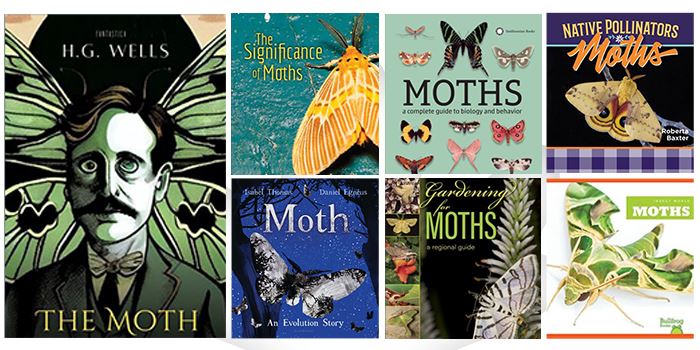Librarian Picks Books Focusing on Moths

Recommended reading on nature-related topics from librarians at the Toledo Lucas County Public Library.
Moths
By Mari C. Schuh
Find it at Your Library: [ebook]
“In Moths, early readers will learn about the life cycle of a moth and discover how the insect's color helps it hide. Vibrant, full-color photos and carefully leveled text will engage emergent readers as they discover the fascinating world of moths. A labeled diagram helps readers identify the insect's body parts, while a picture glossary reinforces new vocabulary.” --bibliocommons
Moths: a complete guide to biology and behavior
By David Conway Lees
Find it at Your Library: [print]
“This richly illustrated guide to their biology, evolution, and history demonstrates the incredible diversity of these winged insects and reveals the ruthless survival tactics used by some including blood-sucking moths, cannibalism in the cocoon, and carnivorous caterpillars. The book also explores their extraordinary life cycle, charting development from egg to larva to cocoon to airborne adult, as well as the surprising variations of color and wing patterns that moths have evolved.” --bibliocommons
The Moth
By H. G. Wells
Find it at Your Library: [ebook]
“Probably you have heard of Hapley-not W.T. Hapley, the son, but the celebrated Hapley, the Hapley of Periplaneta Hapliia, Hapley the entomologist. If so you know at least of the great feud between Hapley and Professor Pawkins, though certain of its consequences may be new to you. For those who have not, a word or two of explanation is necessary, which the idle reader may go over with a glancing eye, if his indolence so incline him.” --bibliocommons
The Significance of Moths
By Shirley Camia
Find it at Your Library: [ebook]
“There is a belief, in Filipino culture, that the recently deceased may return in the form of a moth. Though their bodies disintegrate, their spirits linger on. Fragile but insistent, these spirit-memories permeate Shirley Camia's collection of poetry, The Significance of Moths. In her latest work, Camia exposes her experiences in Canada as a child of immigrants. Although true for many, the newcomer experience magnifies the "strands of the past" that are "bound to the present." --bibliocommons
Native Pollinators: Moths
By Roberta Baxter
Find it at Your Library: [ebook]
“Moths are fuzzier and fatter than their butterfly cousins. A lot of moths are brown and dull looking. Butterflies get songs and poems written about them. Hardly anyone swoons over moths. But moths deserve our respect and attention. Native Pollinators: Moths is a good place to start learning about these fascinating night pollinators.” --bibliocommons
Gardening for Moths
By Jim McCormac
Find it at Your Library: [print]
“"Loaded with stunning color photographs, this practical guidebook, which encompasses the identification of moths, their caterpillars, and their vital roles in Midwestern ecosystems, shows gardeners how to use native plants to attract these essential, but often overlooked and misunderstood, insects" --bibliocommons
Moth: An Evolution Story
By Isabel Thomas
Find it at Your Library: [print]
“A newly-emerged peppered moth blends in with other speckled-winged moths on lichen-covered branches, but over time the moths with black wings increase as trees are blackened by soot from man-made machines.” --bibliocommons
